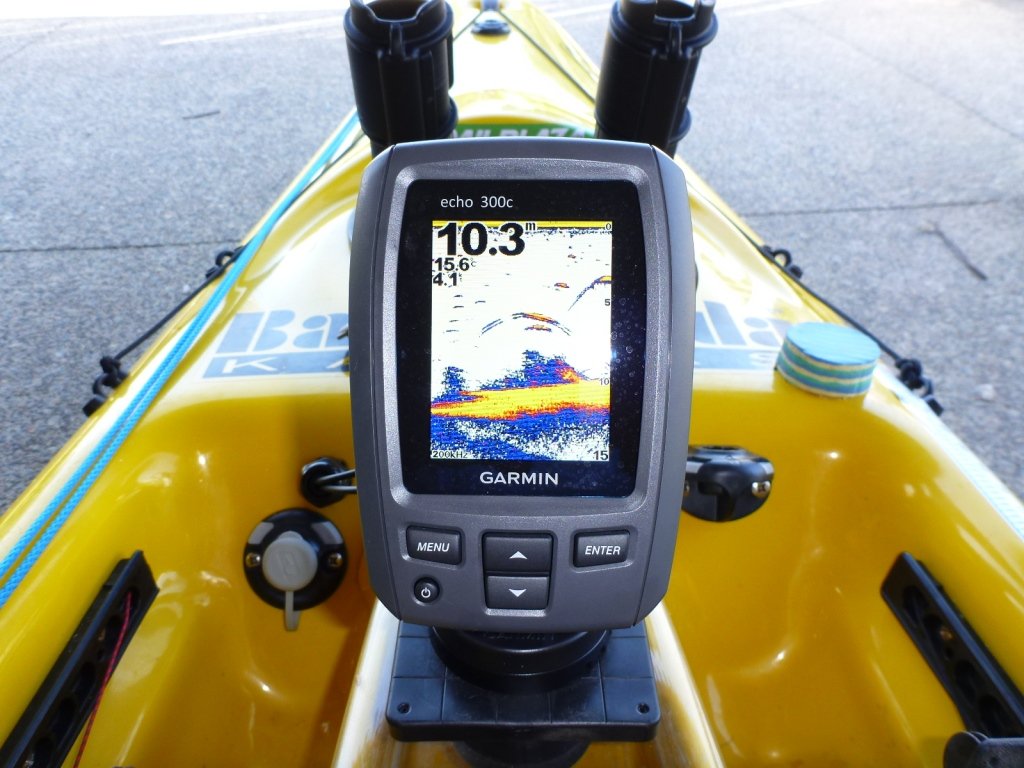
As an Amazon Associate, we earn from qualifying purchases. This is without any additional costs for the buyer but does support us in maintaining our website.
Ask any avid bass fishermen about his electronic fish finder and he will likely tell you that it is one of his most valuable tools! However, kayak fishermen can benefit from the use of a fish finder every bit as much as motor boaters can.
In fact, many fishing specific kayaks have electronics consoles molded into the cockpit combined with transducer compatible scupper holes in the bilge that are specifically designed for mounting fish finders and their transducers. There is absolutely no reason at all why kayak fishermen cannot enjoy the benefits gained from using a fish finder every bit as much as motor boaters do.
So, with that in mind, here’s our list of the best kayak fish finders on the market in 2021.
Revealed: The Best Fishfinder for Kayak Fishing
|
Product |
Screen Size |
No. Freq. |
Max Depth |
Price |
|
|---|---|---|---|---|---|
|
1.9″ x 2,9″ |
2 |
1,600 ft. |
$ |
||
|
3.6″ x 6.0″ |
6 |
2,300 ft./1,100 ft. |
$$ |
||
|
7″ Dia. |
6 |
1,000 ft. |
$$$ |
||
|
7″ Dia. |
3 |
1,500 ft./3,000 ft. |
$$$$ |
||
|
7″ Dia. |
Unknown |
600 ft./900 ft. |
$$$ |
Scroll down to see full reviews!
Kayak Fish Finder Buyer’s Guide:
If you’re not quite sure what you’re looking for, our buying guide is catered for anglers that own a kayak, canoe, or other small boat.
Selecting a fish finder for a kayak is different from choosing one for a larger fishing charter, and you’ve got to really consider where you’ll be fishing as well as your fishing style in order to find a suitable fish finder.
Where Are You Fishing: Shallow or Deep Water?
The first thing that you should be aware of, is that fish finders use a device called a transducer to emit either a single, dual, or multiple sonar frequency and each type has its advantages and disadvantages.
For instance, models that emit low frequencies penetrate the water much more deeply than those that emit high frequencies but, they also display the least amount of detail and therefore, they work best in deep water. If you’re fishing offshore or in deep lakes, then a low-frequency model is recommended.
Fish finders that emit high frequencies penetrate the water less deeply and yet, they display the greatest amount of detail and therefore, they work best in shallow water. If you’ll mostly be fishing rivers, ponds, and shallow lakes, then I would opt for a high-frequency model.
If you’ll be fishing water bodies of varying depth, then you would want to look into electronic fish finders that use transducers that emit multiple sonar frequencies. They often cost more, but don’t box you in to a particular fishing environment. Most modern fish finders have multi-frequency functionality.
In fact, newer models are using a form of sonar called Compressed High-Intensity Radar Pulse (CHIRP) which enables the unit to display the terrain beneath your kayak in amazing detail as well as identifying and displaying any targets between your kayak and the terrain beneath it.
Down Imaging and Side Imaging: What’s the Difference?
Some models have transducers that only display the landscape directly below your kayak (a.k.a. down imaging). Other models have transducers that are designed to scan to the side as well as straight down so that you can note the terrain features along the shoreline.
Down imaging transducers emit their sonar signals in the shape of a cone with the apex located at the point of origin. Cone angles can vary from as little as 9 degrees to as much as 60 degrees.
Therefore, like transducers that emit low frequencies, narrow cone angles are best for use in deep water because they penetrate more deeply, whereas transducers that emit wide cone angles penetrate the water less deeply but, they also provide the best resolution.
Fish finders with side imaging technology are good for inland waterways where fish are likely to be sticking close to the bank. Deep sea anglers may be far from the coastline and fishing for species that are nowhere near the surface and therefore have no need for side imaging.
Other Considerations
By now, you should have a pretty good idea of the features you’ll require. However, there are other factors to consider when purchasing an electronic fish finder such as screen size, resolution, brightness, power levels, and mounting position, which we’ll cover below.
Screen Size
Large screens show greater detail, have higher resolutions, and often have brighter screens which are easier to see in bright sunlight.
However, for kayak anglers, there is a trade-off between a larger display area and available space on your yak. I personally like to the detail that large screens offer and I’m happy with a 7” screen.
Depending on your kayak and where the fish finder is mounted, a 7” may be too large, and a 5” screen may offer better functionality. However, some anglers find that even a 5” screen gets in the way of casting and opt for a 4” screen.
Power Levels
You should be aware that different models of fish finders operate at different power levels. The less power they have, the less deeply the signal can penetrate, and the slower and less clearly the unit will display the readings.
Fish finders that have high power levels penetrate the water much more deeply and have a significantly higher resolution.
GPS
Some fish finders come equipped with internal GPS transceivers. These are extremely useful if you’re fishing well off the coast or in unfamiliar backcountry waters.
GPS enabled models allow you to record your course as well as create “waypoints” so that you can mark, and later easily return to, a good fishing location.
Mounting Position
Before making your purchase, think about how and where you’re going to mount your fishfinder. The obvious position is up front on your deck, but you need to consider potential clashes with rod holders and any other mounted apparatus, as well as the availability of scupper holes to pass transducers through.
A Scotty or RAM fish finder mount will fit most fish finder models and are easily installed with some basic DIY skills (if your kayak doesn’t come with built-in mounting plates).

It can quickly become crowded onboard
Top 5 Fish Finders for Kayak Fishermen:
A single glance at any outdoor outfitter’s web will quickly make it clear that there is a nearly overwhelming number of brands and models of electronic fish finders on the market today.
Choosing a single one from among so many can be a daunting task. However, of all of the fish finders on the market today, the five models listed below are especially well suited for kayak fishing.
Garmin Striker 4 Fish Finder

Garmin has dominated the GPS game for years and used their expertise in the GPS field to make a competitive entry into the fish finder market. The Garmin Striker 4 is a top of the line fish finder that is perfect for kayak fishermen.
It features a multi-frequency Chirp transducer that displays both advanced Garmin HD-ID and DownVü images simultaneously on a bright, crisp, 3.5-inch, high-resolution, VGA color display screen that can be split either horizontally or vertically depending on your preference.
It provides the clearest possible arc returns for nearly photographic details of under the kayak. Also, the Striker 4 features Smooth Scaling which provides a smooth transition when moving from deep to shallow water or vice versa.
With 1,600 Watts of peak-to-peak power, the Chirp transducer cone angles provide a large picture that extends well beyond the sides of the boat. Plus, it includes a nifty sonar history rewind features that allows you to review your scans.
The quick-release, tilt/swivel for the display unit combined with a transom mount make installing the unit a piece of cake.
CLICK HERE FOR MORE REVIEWS AND TO CHECK PRICE
Garmin Striker 7sv Fish Finder

The Garmin Striker 7sv comes packed with features that will greatly benefit any kayak fishermen.
It features a horizontal, high resolution, WVGA color display screen that can be split to show scans using either traditional frequencies, CHIRP, or DownVu and SideVu frequencies with zoom capabilities.
Also, the Ultrascroll feature enables the unit to scan the bottom while you are moving. In addition, AutoGain technology minimizes clutter and maximizes targets, and the adjustable depth line measures the distance to underwater objects. Plus, A-scope technology displays a real-time image of fish passing through the transducer beam and the Fish Symbol ID helps to identify fish targets.
Another cool feature is the integrated GPS transceiver that enables you to record your Course Over Ground (COG) as well as to mark waypoints so that you can quickly return to any given location.
CLICK HERE FOR MORE REVIEWS AND TO CHECK PRICE
Lowrance Elite-7 Ti Touch Combo Fish Finder

Lowrance has long been recognized as a leader in marine electronics, and the Lowrance Elite-7Ti is a top-of-the-line fish finder and chart plotter.
It combines a seven-inch, high-resolution, touch screen, display, with StructureScan HD compatibility that supports Low/Mid/High CHIRP and 83/200 /455/800kHz frequencies.
It also features an integrated GPS transceiver and reliable Lowrance navigation technology that enables you to record your Course Over Ground as well as marking waypoints which save you from getting lost in the wilderness.
In addition, the Elite-7 Ti features Bluetooth and wireless connectivity that allows you to download software updates directly to the unit, as well as Insight Genesis custom maps.
The Elite 7 Series features CHIRP Sonar, StructureScan, and DownScan Imaging technology to provide the best possible view of the landscape beneath your kayak.
CLICK HERE FOR MORE REVIEWS AND TO CHECK PRICE
Humminbird 859ci HD DI Combo Fish Finder

When it comes to anything related to kayak fishing, Humminbird is the name to be trusted. The Humminbird 859ci HD DI Combo fish finder comes with that many features that it’s suitable for both kayak anglers and fisherman who own larger boats.
Featuring a bright, 800H x 480V, 16:9 ratio, high-resolution, TFT color display, you always have an accurate, crystal-clear images even in harsh sunlight.
Combined with the choice of 20-degree or 60-degree transducer angles and DualBeam PLUS sonar channels which can be displayed singly or at the same time, this unit presents an extremely high-resolution view of the world below the surface.
And with 4,000 peak-to-peak watts and SwitchFire Sonar at your disposal, you will have an unparalleled view of what’s below your kayak.
In addition, it features an internal GPS transceiver with integrated GPS Chartplotting and integrated Humminbird ContourXD map and Ethernet Networking capabilities. Plus, it also includes a unit cover, dual card reader and Instant Access buttons. I told you it was packed with features.
CLICK HERE FOR MORE REVIEWS AND TO CHECK PRICE
Raymarine Dragonfly 7 Pro Fish Finder

The Raymarine Dragonfly 7 Pro is ideal for open cockpit installations thanks to spray and submersion protection to IPX6 and IPX7 standards.
The 7 inch, high resolution, screen combined with Raymarine’s award winning CHIRP DownVision technology provides anglers with a vision of the landscape beneath their kayak that is so close to reality, they call it “Visionality”!
It also features dual-beam CHIRP, CHIRP sonar, and CHIRP DownVision combined in a single transducer and a Uni-controller joystick, cursor, and rotary dial with a simple three-button control on the display unit.
In addition, the intuitive user interface simplifies viewing choices and menu options while the integrated 50-channel GPS transceiver with fast-acquisition technology and industry leading, Navionics charts are included on a microSD card.
The Dragonfly 7 has two discrete CHIRP sonar channels; the first of which is an ultra-high resolution DownVision channel, and the second is a high-resolution fish targeting sonar channel. You can view each sonar channel independently, or switch to dual sonar split screen mode for a detailed view of the terrain beneath your kayak.
CLICK HERE FOR MORE REVIEWS AND TO CHECK PRICE
Wrapping It Up
So, if you are looking for a high-quality fish finder for your fishing kayak, the five models listed above are all excellent choices.
If none of the above models float your boat, keep the following information in mind when choosing a fish finder:
- High power levels penetrate deeper waters
- High frequency, wide angle transducers for shallow water
- Low frequency, narrow angle transducers in deep water
- Large screens display more information but take up more space. 5 inch is the optimal size for kayaks.
- GPS is handy for exploration or fishing large areas.
- Micro SD card slots enable you to save and transfer information as well as update your software.
When choosing a fish finder for your kayak, it is important that to be clear on what you need and weigh all of the features offered against the cost of the unit in order to get the best kayak fish finder for you.




Hi Jamie, really the reviews are so informative and useful. Being a passionate fishery I really enjoyed all these here. Definitely, these reviews will help me to choose a best kayak fish finder. Thanks for sharing.
Hi Philip, thanks for the great feedback! I hope you’ve found the best kayak fish finder! Enjoy your fishing!
Well done Jamie, you did a great job. Today I found this blog during surfing over the internet. Really you covered all the topics very well, I became your fan. Thanks for your excellent effort.
First of all, Thanks for such a great article about the best Kayak Fishfinders. I got Garmin Striker 7sv as a birthday Gift from Wife. After using it, I am in love with this Fishfinder. It is one of the best Fishfinders and works great even in Adverse Conditions.